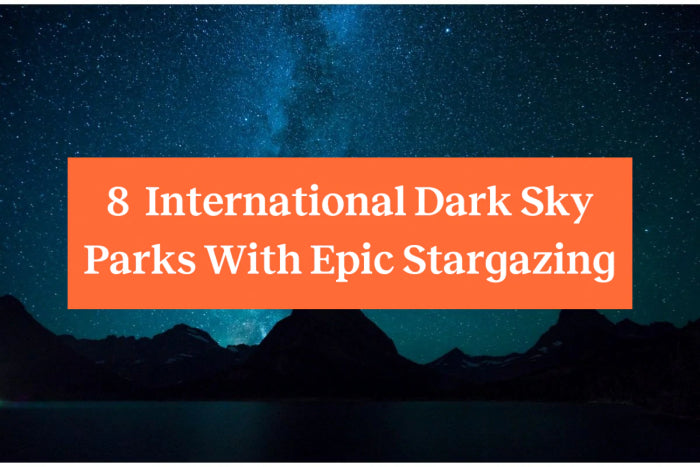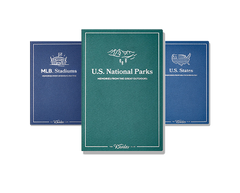
From your backyard, approximately how many stars do you think you can see on the clearest nights? 1,000? A few thousand? It’s actually just 500 or so, give or take.
In stark contrast, you can see as many as 15,000 from International Dark Sky Parks!
The International Dark-Sky Association (IDA) defines an International Dark Sky Park as “a land possessing an exceptional or distinguished quality of starry nights and a nocturnal environment that is specifically protected for its scientific, natural, educational, cultural heritage, and/or public enjoyment.”
There are just over 100 International Dark Sky Parks throughout the world, with fewer than 80 of them in the U.S. (and only a handful are national parks!).
These parks protect far more than “just” dark skies; darkness is crucial to the survival of many plant and animal species, not to mention important for humans’ natural circadian rhythms.
So where can you go to take in some jaw-dropping nighttime scenery, and learn more about the importance of clear, dark night skies? Here are eight of our favorite International Dark Sky Parks.
Stargaze at These International Dark Sky Parks
Would you prefer to visit one of the world's most iconic national parks, or is a remote forest in Maine more your vibe?
Either way, these eight International Dark Sky Parks deliver awe-inspiring stargazing.
1. Big Bend National Park, Texas
Every one of the International Dark Sky Parks on this list is a must-see, but Big Bend National Park in south Texas is a true standout.
It holds the honor of being the darkest of all national parks in the Lower 48, meaning it has the least amount of measurable light pollution.
As you can imagine, Big Bend is one of the absolute best International Dark Sky Parks for stargazing.
NPS offers several astronomy-themed programs throughout the year including moonlight walks and star parties, but you can also have a wonderful stargazing experience by simply bringing a lawn chair and getting comfy under the night sky for a few hours.
Need one more reason to visit Big Bend? The park has another incredibly unique feature: it sits directly on the U.S.-Mexico border, with the Rio Grande serving as the “official” international border.
2. Cherry Springs State Park, Pennsylvania
Cherry Springs State Park in northern Pennsylvania is widely considered “one of the best places on the eastern seaboard for stargazing and the science of astronomy.” That’s largely because of its secluded and wild nature — the park is surrounded by the 260,000-plus-acre Susquehannock State Forest.
Its geography certainly isn’t the only reason Cherry Springs is one of the best International Dark Sky Parks for stargazing, though. The park has not one but two dedicated astronomy viewing areas.
There’s the Night Sky Public Viewing Area, intended for shorter stargazing outings of a few hours or so, as well as the Overnight Astronomy Observation Field.
Both areas feature completely unobstructed 360-degree views of the sky from the top of a mountain, and are literally always open. However, you need to get a Galaxy Pass to use the overnight observation field. Passes are available in January and typically sell out quickly.
3. Glacier National Park, Montana
The National Park Service has a saying for Glacier: “Half the park happens after dark!”
What this means is that the park offers widespread night sky viewing and education programs to very literally connect people with the stars. Most of the programs are hosted during the summer, but time-dependent star parties are held in Logan Pass, as well.
For the best viewpoints, head to one of the lakes. Because Glacier is so mountainous and features varying terrain and elevations, some areas are too heavily forested to see much of the night sky at all. The lakes, particularly Swiftcurrent, St. Mary, and Lake McDonald, provide more open viewing areas.
If you’re lucky and timing is just right, you may even be able to spot the Northern Lights!
Note that many of Glacier’s roads and some of the east entrances close completely in the winter months due to extreme weather.
4. Headlands International Dark Sky Park, Michigan
Northern Michigan’s Upper Peninsula, or “U.P.,” is known for being a scenic and pristine wilderness area. From many places in the U.P., full constellations, the Milky Way, and even the Northern Lights are frequently visible.
One of the best destinations to see these wondrous sights, though, is Headlands International Dark Sky Park. The park is among the oldest designated International Dark Sky Parks in the United States.
Headlands sits directly on the far northern shores of Lake Michigan and is a completely undeveloped park. In fact, the park even encompasses over two miles of undeveloped Lake Michigan shoreline.
That means there’s practically zero light pollution to interfere with stargazing! Even better, the entire night sky is often reflected perfectly in the lake’s shimmering waters.
The park is open 24/7, 365 days a year and even better, it’s always totally free to enter.
5. Natural Bridges National Monument, Utah
You could (accurately) say that Natural Bridges is the O.G. It was the first ever International Dark Sky Park in the entire world, earning the designation back in 2007.
Paving the way for all the International Dark Sky Parks to come, Natural Bridges proves that the little things go a very long way.
For example, all outdoor lights have shields that point the light toward the ground, for safety while walking at night. Motion detector lights are also used wherever possible, to minimize the amount of artificial light emitted.
These “little things” have resulted in one of the darkest, cleanest, and clearest destinations on Earth for stargazing. You can safely explore any area of the park at night, but be aware you’ll have to get away from the campgrounds and parking lots to get shots of the iconic natural bridges.
If you’re heading to Natural Bridges for stargazing, consider making a national parks road trip out of it — Canyonlands, Arches, and Capitol Reef are all within easy driving distance.
6. Katahdin Woods and Waters National Monument, Maine
You may have noticed that most of the International Dark Sky Parks on this list are in the western half of the United States. That’s primarily because the West generally has a LOT more wide-open, public land.
However, that doesn’t mean that there aren’t some incredible International Dark Sky Parks in the east, too. In fact, Katahdin Woods and Waters National Monument (technically an International Dark Sky Sanctuary — and only the 12th in the world!) is home to the darkest skies east of the Mississippi River!
According to Friends of Katahdin Woods & Waters, the monument’s skies measure a 2 on the Bortle Scale, which indicates “only places as remote as Antarctica have darker skies.” Needless to say, you’ll find some of the best stargazing in the world here!
For the best viewing opportunities, head to the Haskell or Big Spring Brook Huts, or the Katahdin Loop Road Overlook.
7. Petrified Forest National Park, Arizona
Fun fact: Arizona has a whopping 19 officially-designated International Dark Sky Communities, two of which are national parks (the Grand Canyon is the other one).
The city of Flagstaff was actually the first-ever International Dark Sky Place, helping to kick off a major movement to protect the Southwest’s exceptionally clear, dark skies.
While Petrified Forest is one of the least-known national parks and not associated with adventure in the same way that, say, Yosemite is, it still deserves a place near the top of your bucket list — especially for stargazing.
The spectacular night sky provides a brilliant backdrop to the ancient, almost otherworldly landscape of Petrified Forest. And bonus, desert sunsets in the park are jaw-dropping! So bring some chairs and a picnic dinner, settle in just before sunset, and make yourself comfortable.
8. Valles Caldera National Preserve, New Mexico
One of the newest International Dark Sky Parks, Valles Caldera in northern New Mexico earned its designation in February 2021.
The landscape and history in Valles Caldera are unique and fascinating in their own rights; the phenomenal night sky is just icing on the cake.
A massive volcanic eruption over one million years ago created the 13-mile-wide caldera, forming expansive meadows, gently rolling mountains, stands of old-growth pine forest, and countless wild streams. Today, the preserve is home to diverse wildlife including elk herds and wild turkeys.
Explore all that by day, then stay into the night to experience some of the best stargazing and astrophotography anywhere. The best viewing points (which also happen to be easily accessible) are the pullouts along NM State Route 4.
Because Valles Caldera is a newly-designated International Dark Sky Park, astronomy programs are still in development. The park plans to offer them from May through September 2022.
Have you been to any of these International Dark Sky Parks, or do you have other must-see suggestions?
Regardless of which ones you’ve visited and which ones are now on your bucket list, one fantastic way to honor them is with a unique travel souvenir. Check out The Wander Club’s Travel Tokens and Token Holders!
We offer U.S. National Park Tokens, state and country tokens, landmarks, and even completely custom creations! Get yours today and start planning your next stargazing adventure!


















































































